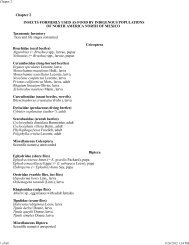Armillaria Root Disease - Wisconsin Horticulture - University of ...
Armillaria Root Disease - Wisconsin Horticulture - University of ...
Armillaria Root Disease - Wisconsin Horticulture - University of ...
Create successful ePaper yourself
Turn your PDF publications into a flip-book with our unique Google optimized e-Paper software.
<strong>University</strong> <strong>of</strong> <strong>Wisconsin</strong> Garden FactsCan I save a tree affected by <strong>Armillaria</strong> root disease? There is nopractical way to eliminate <strong>Armillaria</strong> from trees that are already colonized by thefungus. The useful life <strong>of</strong> an affected tree might be prolonged, however, bysupplemental watering during dry periods and appropriate fertilization to improveoverall host condition. In very vigorous trees, the pathogen may be “walled <strong>of</strong>f” andconfined to just a portion <strong>of</strong> the root system or root collar. There are no chemicaltreatments that can effectively target the <strong>Armillaria</strong> fungi within diseased trees.How do I avoid <strong>Armillaria</strong> root disease in the future? Practices thatmaintain trees in vigorous condition are the best means <strong>of</strong> preventing <strong>Armillaria</strong> rootdisease. Watering and fertilization to avoid stress will help trees resist infection.Because <strong>Armillaria</strong> root disease <strong>of</strong>ten develops in response to defoliation,suppression <strong>of</strong> both insect and leaf pathogen defoliators will indirectly reduce theoccurrence and severity <strong>of</strong> <strong>Armillaria</strong> root disease. Because stumps and rootsystems <strong>of</strong> previously colonized trees can serve as “food bases” supportingrhizomorph growth for many years, thorough removal will reduce the risk <strong>of</strong> infection<strong>of</strong> other trees.For more information on <strong>Armillaria</strong> root disease: Contact your countyExtension agent.© 2002 by Glen R. Stanosz, all rights reserved.An EEO/Affirmative Action employer, <strong>University</strong> <strong>of</strong> <strong>Wisconsin</strong>-Madison provides equal opportunities in employment and programming, including Title IX and ADA requirements. This document can beprovided in an alternative format by calling Brian Hudelson at (608) 262-2863 (711 for <strong>Wisconsin</strong> Relay).References to pesticide products in this publication are for your convenience and are not an endorsement or criticism <strong>of</strong> one product over similar products. You are responsible for using pesticidesaccording to the manufacturer’s current label directions. Follow directions exactly to protect the environment and people from pesticide exposure. Failure to do so violates the law.Thanks to Ann Joy and Brian Hudelson for reviewing this document.A complete inventory <strong>of</strong> <strong>University</strong> <strong>of</strong> <strong>Wisconsin</strong> Garden Facts is available at the <strong>University</strong> <strong>of</strong> <strong>Wisconsin</strong>-Extension <strong>Horticulture</strong> website: wihort.uwex.edu.
















